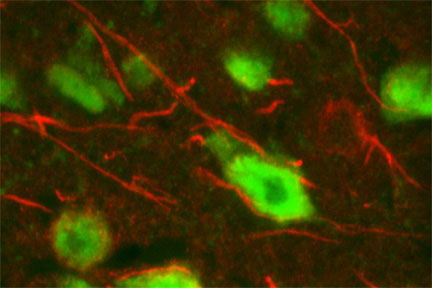NIDA-supported researchers Drs. George Wilcox and Carolyn Fairbanks at the University of Minnesota in Minneapolis and Dr. Robert Yezierski at the University of Miami have demonstrated that a recently discovered compound appears to alleviate chronic pain. The investigators, led by Dr. Wilcox, are studying agmatine, an amino-acid-like substance produced in the brain. They have found that in laboratory mice and rats, agmatine appears to relieve chronic pain caused by nerve damage and inflammation. (See "Acute vs. Chronic Pain," below.)
The research team injected either agmatine or saline solution into the spines of rodents that had pain associated with nerve damage due to chemically induced inflammation or surgically induced spinal cord injury. The researchers found that the animals treated with agmatine showed reduced sensitivity to this pain.
 In this microscopic image of a mouse spinal cord, the long, thin strands show cellular processes or fibers containing agmatine. When administered from outside the , agmatine appears to reduce the symptoms of chronic pain.
In this microscopic image of a mouse spinal cord, the long, thin strands show cellular processes or fibers containing agmatine. When administered from outside the , agmatine appears to reduce the symptoms of chronic pain."Agmatine seems to interrupt the cascade of changes that occur in the nervous system after nerve damage," says Dr. Wilcox. Agmatine, thought to be a neurotransmitter like dopamine or serotonin-substances that act as chemical messengers between nerve cells-counters the effect of another brain chemical, glutamate. Glutamate, which is released in large quantities following injuries, promotes pain by damaging and destroying nerve cells.
"Agmatine is not a typical pain reliever," says Dr. Fairbanks. "It appears to selectively reduce the chronic pain resulting from nerve damage or inflammation, but not the acute pain caused by normal injury."
In the study with rodents, Dr. Wilcox notes, "the relief provided by agmatine appeared to be permanent, unlike the temporary relief provided by medications like morphine." Moreover, agmatine seemed to produce none of the serious side effects seen with morphine and related drugs, such as sedation, respiratory depression, and loss of coordination.
Agmatine still has to go through many stages of testing before scientists will know if it can be a safe and effective treatment for people. Meanwhile, these early findings with the compound are hopeful for chronic pain sufferers.
Acute vs. Chronic Pain
Physical pain comes in two varieties: acute and chronic. Acute pain can occur during transient illnesses or after an injury or surgery and goes away once the condition clears up or wound heals. In acute pain, pain-specific nerves respond to noxious stimulation or injury by releasing chemicals that transmit pain signals to the spinal column and brain. This type of pain can be treated effectively with short-term use of opioids or other pain-relievers, which generally pose a minuscule risk of addiction.
In contrast, chronic pain may be caused by nerve damage, chronic diseases such as cancer and arthritis, and degenerative conditions such as spinal cord injury. While chronic pain is complex and not well understood, research suggests that prolonged disease states or tissue injury may sensitize certain nerves in pain-signaling pathways. As a result, these nerves may continue sending pain signals to the brain even when the pain-causing condition has been resolved.
Chronic pain is a difficult-to-treat, persistent condition that often requires long-term use of medications. With prolonged use of opioids, some patients require increasing doses to control their pain and patients may develop withdrawal symptoms if the drug is stopped. NIDA-funded researchers have been spearheading the exploration for new painkillers that are effective in treating chronic pain but do not produce withdrawal symptoms and are not addicting.
NIDA's Dr. David Thomas says, "In addition to our interest in how opioids work and in developing better opioids for the treatment of pain, we are searching for alternatives to opioids because of their abuse potential and because they are not effective for reducing some types of pain, such as pain caused by nerve damage and inflammation."
Source
- Fairbanks, C.A.; Schreiber, K.L.; Brewer, K.L.; Yu, C-G.; Stone, L.S.; Kitto, K.F.; Nguyen, H.O.; Grocholski, B.M.; Shoeman, D.W.; Kehl, L.J.; Regunathan, S.; Reis. D.J.; Yezierski, R.P.; and Wilcox, G.L. Agmatine reverses pain induced by inflammation, neuropathy, and spinal cord injury. Proceedings of the National Academy of Sciences 97(19):10584-10589, 2000. [Abstract]
